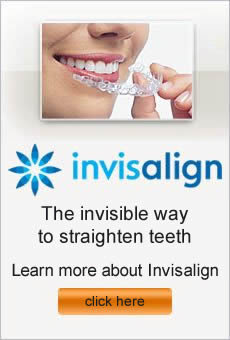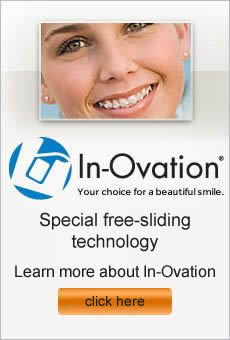After you finish orthodontic treatment, you should enjoy a stunning smile. Unfortunately, your teeth will naturally want to shift out of alignment. Most orthodontists have their patients wear retainers as the final phase of orthodontic therapy. These oral appliances work to keep teeth in the desired position.
What types of retainers are available?
At one point, orthodontists only used the plastic and wire retainers. This is still the most common type of retainer. Clear, plastic retainers have recently gained popularity. These devices also work well to keep teeth in place.
How long will I need my retainer?
Initially, you will probably wear your retainer about 22 hours a day. Your orthodontist will monitor your progress and let you know when you can cut the time back. Most patients will wear their retainers for several years after treatment to ensure that teeth don’t shift.
Should I wear my retainer while I play sports?
If your appliance fits well, you can wear the retainer because no risk exists to your teeth; however, the device could fall out and sustain damage. Keep in mind that retainers don’t function as mouth guards, so you still need to wear that appliance to protect your mouth.
How do I care for my retainer?
When you remove the appliance, make sure to gently brush and rinse it before storing the retainer. Always place the retainer in its case when you aren’t wearing the appliance so that it doesn’t get broken. Put the case in safe place, out of reach from young children or family pets.
Orthodontic retainers at Mehdi Fotovat Sherman Oaks Orthodontist
When most people think about orthodontics, they envision braces or retainers. Sometimes, your orthodontist may recommend a temporary anchorage device (TAD). Made of titanium alloy, the TAD is a miniature screw that serves as an anchor to move teeth in a very controlled manner. Because the TAD does not move, the tooth or teeth can move against a fixed point to create the desired results.
Your orthodontist can place the TAD in the office, with minimal discomfort. After numbing the area with a fast-acting gel and applying local anesthetic, the doctor will insert the appliance through the gums into the bone between your teeth. Most people experience a feeling of some pressure, but no actual pain. Usually, patients respond well to the procedure, with no need for even over-the-counter medications like ibuprofen or acetaminophen.
Because the device is temporary, your doctor will monitor the progress and remove the screw once the teeth have shifted as desired. Usually, patients only wear TADs for a few months. If the TAD irritates your cheeks or lips, use a q-tip to apply orthodontic wax and cover the device. Call your doctor if the discomfort persists.
For the first week, rinse the TAD with chlorhexidine two to three times daily. You will also need to use a soft toothbrush dipped in chlorhexidine to brush around the post during the initial seven days after placement. After this point, treat the TAD like a tooth by brushing at normal times. With a TAD, you may feel some loosening, which is normal. If it feels excessively loose or becomes uncomfortable, contact your orthodontist.
Temporary Orthodontic Appliances at Mehdi Fotovat Sherman Oaks Orthodontist
Choosing orthodontic treatment for yourself or a loved one is a big decision. Before taking this step, you need to gather detailed information about what this process entails. Getting answers to your questions will help you determine the best treatment and find an orthodontist you can trust to create a flawless smile.
Consider talking about these questions with your orthodontist:
Does having braces hurt?
Many kids, and adults, worry that traditional braces cause pain. While, you may experience some initial discomfort, your mouth will get used to the brackets. Your orthodontist can make recommendations to help during the adjustment period.
How long will treatment last?
Though the answer is often dependent on the severity of the problem and the compliance of the patient, your orthodontist should be able to provide an estimated time frame.
Are there different types of orthodontic treatment?
After evaluating your mouth, your orthodontist will explain the available options. Depending on your age and the issue you want to correct, your doctor may suggest traditional braces, ceramic brackets, or clear aligners for older teen and adults patients.
Do I have to change my diet?
During orthodontic treatment, you need to protect your braces from damage, so stay away from sticky or hard substances. Ask your orthodontist for a list of foods and snacks to avoid.
Will my teeth shift after the braces come off?
Once you complete the active stage of treatment, you will need to wear a retainer to maintain those results. To protect your new smile, the orthodontist will create custom appliances and then review the amount of time you need to wear the retainers.
Orthodontic Treatment at Mehdi Fotovat Sherman Oaks Orthodontist
Do you cringe at the thought of metal braces, but still want to obtain a fantastic smile? You shouldn’t have to sacrifice your mature image to straighten your teeth. With Invisalign clear braces, you don’t have to endure the discomfort or embarrassment of traditional orthodontia.
Adult and older teen patients often love the option of Invisalign clear braces. Through a series of clear, custom aligners, this advanced system gently shifts crooked teeth into the desired position. With these virtually undetectable aligners, only you and your orthodontist will realize that you are undergoing treatment to improve your smile.
Before beginning treatment, your orthodontist will first complete a full analysis to make sure Invisalign is the right solution for your case. Your doctor will then take photos and collect data to create an exact treatment plan. Using advanced 3-D technology, the Invisalign lab will translate the orthodontist’s instructions into a complete series of aligners.
During treatment, you will wear each aligner for around two weeks; then, switch to the next aligner. You will visit the orthodontist every four to six weeks so that the doctor can monitor your progress. Remove the aligners when you eat, brush, and floss, or for special occasions. In about 12 months, you can reveal a flawless smile to family and friends.
Benefits of Invisalign:
• Makes cleaning and home care easier
• No bulky metal brackets
• No painful adjustments
• Usually requires less treatment than traditional therapy
Invisalign at Sherman Oaks Orthodontist Mehdi Fotovat Valley Village, CA
Although most people want a straight smile because it looks good, you receive other benefits of orthodontic treatment. Crowded and crooked teeth are harder to maintain, which can result in increased problems with tooth decay or gum disease. As well, a bad bite, or malocclusion, can make chewing difficult and cause uneven tooth wear.
Common orthodontic issues include:
Crossbite
This type of problem occurs when the upper teeth rest significantly inside or outside the lower teeth. Crossbites make chewing tough and can cause issues with proper jaw growth.
Crowding
A small mouth, larger teeth, or a narrow jaw can make it difficult for permanent teeth to move into the correct spot.
Deep overbite
If the incisors, the upper front teeth, overlap too far over the lower teeth, a deep overbite results.
Under bite
The lower teeth can be positioned ahead of the upper teeth and create an under bite, which may suggest that the jaws are not in the right position.
Open bite
When your upper and lower teeth don’t meet as you bite down, this condition is called an open bite. Having an open bite can make biting difficult, impact speech, and produce uneven wear on teeth.
Spacing problems
If an individual has particularly small teeth or has lost teeth, this situation can produce larger spaces between teeth.
Because each person’s bite is different, the orthodontic treatment course will vary slightly from individual to individual. Braces are a common choice to correct bite issues. Your orthodontist will evaluate your mouth and then create a detailed plan for improving your smile and oral health.
We create beautiful smiles at Mehdi Fotovat Sherman Oaks Orthodontist



